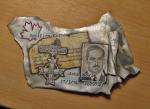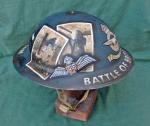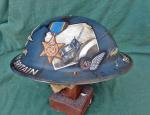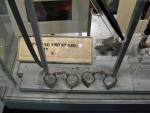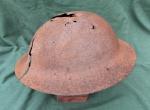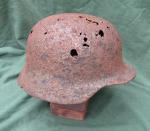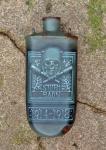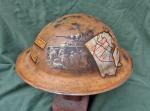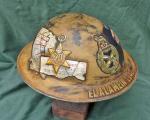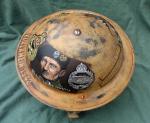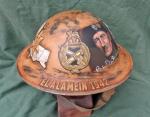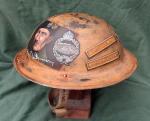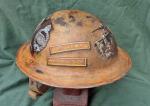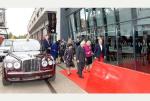-
Posts
1,869 -
Joined
-
Last visited
-
Days Won
7
Content Type
Profiles
Forums
Blogs
Gallery
Events
Store
Everything posted by Spasm
-
Stunning, just stunning
-
A very small piece (6" by 3.5") of a Spitfire (X4426) which was shot down and crashed on Erriott's Farm at Dadmans, Lynstead at 10.37am on 28 Sept 1940. The pilot, F/O John "Beryl" Boyle was from Castlemain, Ontario, he was 26 years old. He is buried at Lynstead New Churchyard in Kent.
-
Frank, he he, thank you. You'll like the next bit of tin I've found. Only very small but very Canadian. I'll need a size 0000 brush and hopefully can do it justice.
-
-

Brodie Helmets
Spasm replied to paul kennedy's topic in Great Britain: Militaria: Badges, Uniforms & Equipment
Ah, ok. Which is probably why the original patent isn't available then as it became war stuff and not available to any Tom, Dick or Harry. I expect, then, that Mr Brodie became pretty well off, or maybe the Army and Navy stores? No wonder they are still in Victoria Street. It's in my head now too...........a long long way to go -
They also had one of these. A fire watcher's shelter that were positioned on the roofs over the city. The rain had stopped as I left with this view over the old docks and the Arnolfini museum (which has some very weird artworks to bemuse yourself over so off I went for a gander, but that's another story).
-
Mervyn Went back to have another look at the truncheons etc. The weather wasn't too good, it was raining cats and dogs, so there were quite a few people walking around. When I asked if I could get the truncheons out of the cabinet it looked like I'd asked to kill their first born. I was told that I couldn't take photos of the items just in case they exploded or something! So I tried to get photos of them in the case, the flash didn't help due to the cabinet glass and every snapshot got the staff very excited until I asked them to calm down a bit as the public were getting anxious and moving towards the door and the rain. The cabinet was obviously about the Bristol Riots and you can just make out the end of an iron rod. Probably from a railing that has an inscription painted in gold lettering - "This bar was wrested from the hand of the first of the Bristol rioters that came to destroy the Bishop's palace".
-

Brodie Helmets
Spasm replied to paul kennedy's topic in Great Britain: Militaria: Badges, Uniforms & Equipment
I believed Mr Brodie held a patent for his design of helmet so I went to have a gander at the patents listed under his name. He has 11 listed - 5 are for various methods in distilling and manufacturing salt and 6 related to protective headgear and improvements to said items Improvements to Mosquito nets, dated 8 Apr 1915, sketch shown below is for a net impregnated with a solution to "drive off, or kill insects" that fits over a hat, cap or bandaged head. The helmet improvements, shown below, are dated 16 Aug 1915 and 19 Nov 1917, one of them - (the removable shell) includes "the shell is coloured to make them less visible". Note how similar one of them is to the prototype US helmet shown in Tony's book above. The last two, which have no drawings, are dated 16 Aug 1915 in France for "Casque ou bouclier pour la tete" (Helmet or shield for the head) and 27 June 1916 in the US for "Helmet or head shield" There doesn't seem to be one for the actual Type A helmet. Is this why the US had the Doughboy, oops I meant Doebouy (sorry Brian I always thought it was Doughboy after that Pillsbury advert), while France kept the Adrian and is the actual patent for the original helmet gone due to Britain producing the MkI. ? -

Brodie Helmets
Spasm replied to paul kennedy's topic in Great Britain: Militaria: Badges, Uniforms & Equipment
Toot toot, go ask these guys http://thebrodiehelmet.weebly.com/ lots of info and lots of IDs on helmets across the world. Do you think Brodie got a bonus from the Army and Navy? Tony, good book download. But it didn't have the sniper plate I've just got hold of. -

Brodie Helmets
Spasm replied to paul kennedy's topic in Great Britain: Militaria: Badges, Uniforms & Equipment
By the way, very very nice helmets you guys. -

Brodie Helmets
Spasm replied to paul kennedy's topic in Great Britain: Militaria: Badges, Uniforms & Equipment
Ah, the world of helmets.... Without going into too much detail and not getting into liners and manufacturers - pretty easily found if Googled (the maker's mark is stamped in the rim) The French were the first to introduce the helmet to front line troops with the Adrian M15 - there's a picture of Churchill wearing one in the trenches (and we all know he liked to be protected). The obvious protection to the troops from head wounds caused by shrapnel had the British looking around for their own. A Mr John Brodie, who worked for the Army and Navy stores in London came up with a much simpler design. The Army and Navy were the suppliers of almost anything military, go have a look at some of their sales catalogues from the Victorian era. As the design was simpler to manufacture, stronger and all round just better than the fireman's based French one and also as it was based on the 11th-14th century kettle helmet that mashed the froggies while they played at home. This was the design adopted in late 1915 as the War Office Pattern Brodie. The original Type A Brodie, made from mild steel, went into manufacture but only 4,400 were ever made over a few weeks. A metal guru, Sir Bob Hadfield, proposed a better steel that was part manganese. This was called mangalloy which was used to manufacture the Type B Brodie from October 1915. Both Type A and Type B are rimless or have a raw edge (like the WW2 German M42). The Type B is non-magnetic. The raw edge was seen as dangerous in itself and the helmets were pretty uncomfortable so a redesign took place. The Helmet Steel MkI with the added rim started manufacture in 1916 and was used through to the mid 1930s in Britain, much later elsewhere such as Belgium and Israel. Those in use or in stores were refurbished with a new liner and chin strap and allocated the MKI* (mark one star) name which is when the bolt fixed liner replaced the rivet in the crown of the helmet. Later helmets are all mostly stamped with date and manufacturer on the rim by the chin strap bale, these are known as MKIIs. I'm sure there's an even greater depth of detail but that's all i can hold in my head. All helmets of this shape and form are known as Brodie helmets - even the ones manufactured abroad. The real beardy types, anoraks and train spotters would only consider the type A and B as true Brodies. By the by, not all MKIIs are British or even issued to troops. Ones with three holes drilled over the ears on each side didn't pass quality control so were issued to tea ladies. Ones with three holes drilled around the rear rim were manufactured in South Africa, likely for a neck shade (although some say for a camo netting over the face) and ones with brown liners are not British but more than likely Belgium manufacture from the 50s. -
Wow, that's pretty neat - you recognising it and me realising that it's out there. I post the stuff and then sort of forget that it is still around somewhere. Also good to know that people see my stuff as re-sellable. Thanks for letting me know.
-
Getting stuck in.... Here's the WW1 British being filled and then all base coloured up. It's going to be painted to commemorate Dave Gallaher, the Captain of the 'Originals'. The New Zealand rugby team that toured Europe and North America in 1905/6 and was the first team to be known as the All Blacks. Dave Gallaher joined up again in WW1, having served in the Boer War, when his younger brother Sgt Major Douglas Gallaher was killed with the 11th Australian battalion at Laventie. Dave lied about his age stating he was 41 when, in fact, he was 44. Sgt Gallaher's helmet was penetrated by shrapnel in the attack on Gravenstafel Spur on 4th October 1917, he died later that day. He is buried in Nine Elms Cemetery. His gravestone bears the famous Silver Fern of the All Blacks and gives his age of 41. His brother Henry who served with the 51st Australian battalion was killed on 24 April 1917. Henry's twin brother Charles survived after being badly wounded at Gallipoli and died in 1950. We'll see how it comes out. The helmet is backed up by a sniper plate, British I believe. It weighs a ton and will also be given a bit of a spruce up.
-
Larry, thank you Once all the base colours and camo is done and aged and I have done research for medals, pictures, history etc I print out the pictures to the right scale and position on the helmet. I get through reams of paper and I buy ink cartridges in bulk. I then trace these directly onto the helmet in their correct position. Then its just a matter of colouring them in, a bit like painting by numbers. Easy, but very time consuming. I do each element separately and apply an intercoat of lacquer over the pencil (so that i don't rub it off as I'm painting) and another coat over each element as it is finished. A final two or three coats of lacquer is then applied once complete. I used to do everything freehand but it just takes too long. Given the detail that collectors look for in medals and vehicles getting the lettering, panel positions, number of leaves in a scroll etc etc right is important. Portraits, figures, clouds, scenery etc I do freehand. Portraits, especially colour ones, take me a whole day. As I've moved on since doing my last 'how to' when I did the SA helmet as a competition prize a couple of years ago, maybe I'll do another to get my post numbers up. I owe you lot another one anyway, any ideas?
-
Lambert, The base and worn tops colours take about a day and then the detailed paintings take about 4 days, obviously depending on what they are. Also the preparation of the helmet to take paint can take ages especially if it needs the mud and rust removed and the shell rebuilding to reform edges and filling, sanding and filling. If its a poor condition helmet it can take a full week of work while a helmet in pretty good condition, like the one above, takes me 4 to 5 days. Thanks for asking and showing an interest. Go get yourself an old relic and have a go......it gets you to do some historical research, builds skills (particularly sanding and repair of body panels which is handy for when the other half borrows the car) and gives you neck/back ache bending over something for so long.
-
And these have a bit of rot, woodworm and need repairing so that they open and close without falling to pieces. One ammunition and one stick grenade. Don't know what these will end up with, probably troopers and unit markings
-
-
-
-
Mervyn You are quite right, I'm making no comment on that. I plead the 5th m'lord. I should be back there this week so expect some more pictures and notes. They don't hold the Mayor's maces there, I believe they are in his chambers and council room when they officially sit discussing cycle routes and slavery. But they will be out again next month on Remembrance Day. I will accost the Bill's armed gang then and get some closer pictures and maybe some details on history etc from the plods themselves. Photos are looking pretty good again but I'm a bit finiky/phinikey/finikee/finicky fussy as a judge and expect to take some time pouring over them next week. My marking spreadsheet is all ready.
-
Geertsen Unfortunately not all are available: "The majority of WW1 service records for ranks other than officers were destroyed during a 1940 air raid. Those that survived - fewer than 40% - are available either at Kew (WO 363, the so-called Burnt Documents), or on-line through Ancestry. The chance of finding a service record varies greatly from regiment to regiment." Maybe the Arty type chaps on here will be able to help. You might find some rolls through the Royal Field Artillery sites. Sorry, not much help but it might be why you can't find your man.
-
Mervyn - I'll be paying another visit next week. It wasn't very busy when i was there (probably due to my mate, the Pres, visiting), if there's only a couple of people about, I'll have a word with the nice young ladies to see if I can't get the cabinet opened. Yes, the Mayor is a bit of a carrot. But he's building new cycle paths everywhere so us walkers get regular massive adrenaline rushes and heart exercise whenever a cyclist bombs passed from behind ringing those stupid new ding dong bells. Just wait till I need a walking stick.
-
Here he is. Nice bloke. The big Geezer wasn't so nice though, but he was polite. The silly looking one with the red trousers is George - our new mayor. Obviously they are wondering why there are large muddy footprints on the carpet. Brian - I'll have a gander when I go back next week and take my glasses.




